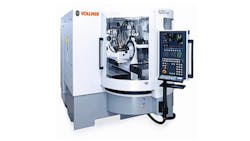Precision Cutting to Achieve Precision Grinding
The need for greater precision in grinding never decreases, nor does the need to grind more materials to higher standards of precision. Take, for example, Sinjin Diamond – a South Korean producer of ultra-precision diamond cutting tools used to produce eyeglasses and contact lenses: To produce those diamond-tipped profile cutters, Sinjin is counting on the precision of the Vollmer QXD 200 eroding machine.
The profile cutters are mainly used to machine glass or plastic lenses for glasses.
The history of producing corrective lenses is long, and still evolving: about half the world’s population may be affected by vision impairment or eye diseases. The best-known treatments are vision aids, such as glasses and contact lenses, made from glass or plastic. Glasses were invented in Italy in the 13th century, even though the ancient Egyptians knew the recipe for glass around 5000 years ago: Sand, ash, and chalk.
Two Germans, Adolf Eugen Fick and August Müller, working independently, created glass contact lenses, around 1880. However, contact lenses only really made a breakthrough in the mid-20th century, once high-quality synthetics such as acrylic glass could be used to produce them.
Micrometers Matter
Today, most lenses in glasses are made from high-quality synthetics, too. Regardless of whether glass or plastic is used, how the lenses of glasses and contact lenses are processed is critical: The more precisely they are ground, the sharper will be the subject’s the vision.
It has been a long time since lenses were ground by hand. Instead, ultra-modern CNC-controlled diamond tools are used, like those developed by the South Korean company Sinjin Diamond.
"When grinding the lenses of glasses, and even more so in the case of contact lenses, precision as accurate as a few micrometers is required. To enable this, we produce tools from natural and synthetic mono-crystalline diamonds, with tips just a few micrometers in size," explains In Sun Cha, President of Sinjin Diamond. The company was founded in Seoul more than 35 years ago, and now employs 20 people.
In the global market for ultra-precise diamond tools, Sinjin Diamond is s technology leader, with a market share of around 30%. Particularly in the case of diamond tools with "controlled waviness," Sinjin Diamond is one of just a few providers worldwide.
Waviness is an undesirable side effect of machining surfaces with rotating tools. The waviness denotes the deviation from the norm, or how much the actual product deviates from the drawn plan. This deviation should be as small as possible. Tools with controlled waviness monitor this deviation from the norm during machining, thus guaranteeing previously defined error tolerances.
"We supply diamond tools with a controlled waviness of less than 50 nanometers,” according to In Sun Cha. “Both insert systems and monobloc systems are available.
“We deliver these ultra-precise diamond tools throughout the world,” Cha continued. “They are not only used for contact lenses, but also for the production of cameras, telescopes, and laser printers."
Lenses and mirrors for cameras and telescopes may have a diameter of 20 centimeters or more. These too are developed using the technology and insights of Sinjin Diamond. And, every single laser printer works thanks to the use of diamond tools! They grind polygon mirrors that deflect the laser light inside the laser printer, and light the image cylinder for printing.
"In an increasing number of technical applications, the force of the diamond dictates the level of quality and functionality," Cha said. "For this reason, we sought out a Vollmer sharpening machine for machining diamonds. It allows us to reach the level of precision that our customers expect from our products."
With the Vollmer QXD 200 eroding machine, Sinjin Diamond manufactures diamond-tipped profile cutters, which are primarily used to machine glass or plastic lenses for glasses. Thanks to the eroding machine, a profile cutter can be fully sharpened with a surface roughness of less than one micrometer in four to five hours.
The Vollmer machine achieves this high precision because it measures, erodes, grinds, and polishes the edges of the diamond-tipped milling tool in a single clamping. This full machining is based on six CNC axes that control the eroding process and make manual intervention superfluous.
"An integrated tool changer and comprehensive workpiece guidance mean that we can use the QXD 200 to machine our profile cutters without manpower all day long – that's a good 40 per week!" according to In Sun Cha.
